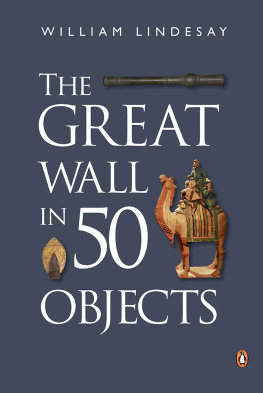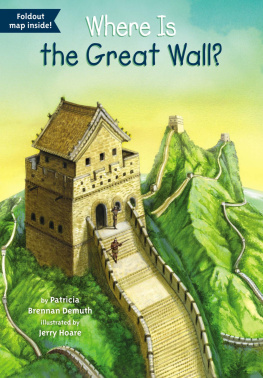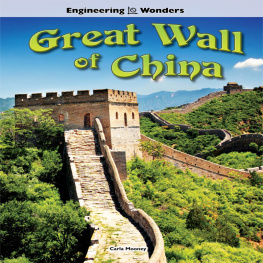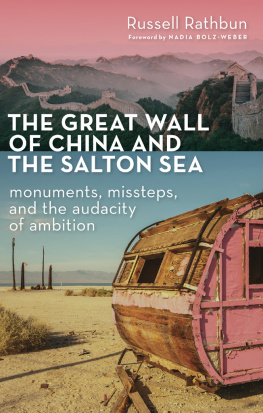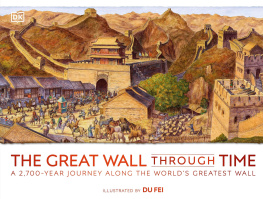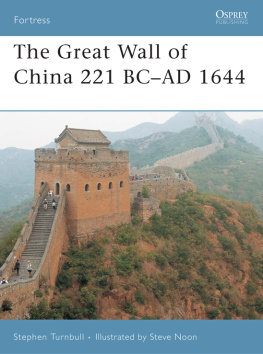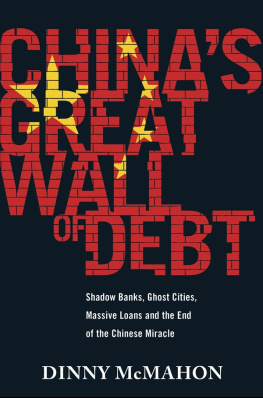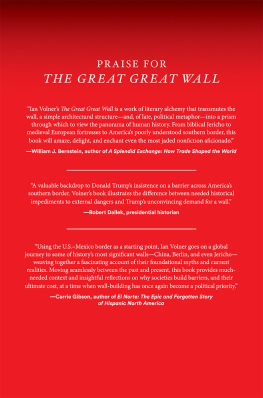A cknowledgements
As I write this thank you letter to all those who gifted me with the opportunities, trust, access, help, answers and photographs that made this Great Wall 50 adventure possible, fun and successful, I face a familiar problem, nice though it is: where to begin?
Appropriately, I have in front of me an assisting object, made in 2012. Its a thick wedge of papers, clipped together: a kind of project antiquity. The papers are roughly-cut rectangles, about the size of playing cards. The stack is composed of about thirty-five pieces, and each paper bears a few words, written clearly in thick, black ink.
My youngest son, Tommy, then aged twelve, saw me exasperated as I struggled with a document on my computer screen, cutting and pasting. I was trying to bring some semblance of order and sequence to my draft list of objects. With paper, scissors and pen, he made folds and cuts, and then wrote down the titles of my objects on them. A game began.
The purpose of the game was to make connections. Some pairings related to the objects materials for instance, metal, wood, paper or stone. Another approach was based on functions: weapons, maps, messages, books or paintings. Origins worked too: Chinese, nomadic or international. As well as matching pairs to highlight similarities, opposite pairs also worked in an intriguing way, and I ended up launching with one of them: the contrasting ways in which Europeans and Chinese first learned of the Great Walls existence.
Tommys system worked well back then for its simplicity; now, the same papers perform a different function. Theyre like business cards, reminding me of who helped with what object. Some of them, grouped together, show me just how much certain institutions helped.
If I could award a gold medal for accessibility and openness, then without a second thought it is awarded to Mrs Nemekhbayar Nadpurev, owner of the Museum of the Great Hunnu Empire, to whom I am greatly indebted. Just months after the passing of her husband, the founder of the museum, Purevjav Erdenechuluun, whom I had met the year before, she and her staff accorded me every possible help, permitting me to examine bronze ornaments, weapons, armour and ritual articles from the collection. Ultimately, I included six objects from the museum in my final fifty.
Elsewhere in the Mongolian sphere, a number of people offered very special help. Mrs Buuma of the National Museum of Mongolian History assisted me with various objects from the collection, while the curator, Professor Saruulbuyan, was most enlightening as he shared his ideas. Special thanks are also due to Kirk Olson and his wife, Oyuntuya Bayanjargal, for their work in finding various people in Mongolia, in interpreting in the archery workshop of the Batmunkh family, and in organising an outstanding expedition across the Mongols ancient homeland, the Great Eastern Steppe. I also offer many thanks to Professor Jack Weatherford for guiding me towards a better understanding of nomadic culture and of the history of the Genghis Khan period.
Although this off-Wall book took me away from the ruins, you will have noticed that I have woven into many of the stories various field experiences, encounters and observations from over the years, ever since my first steps on the Wall in 1986. On all my Wall trips Ive benefited from the support and friendship of many people. In the early years, my biggest thanks go to those farmers who helped me along the way with food, water and shelter. In the mid-1990s I explored the Wall in the Beijing region with a succession of people who became dear companions. My memories of short adventures with Scott Urban, Tjalling Halbertsma, Yang Xiao, Wang Baoshan and Piao Tiejun are unforgettable and will always be at the heart of my Great Wall experiences: they were the golden years.
Elsewhere in China, I thank Pan Yue from the Shanhaiguan Great WalI Museum; Hou Jingang and Yu Chunrong from the Jiayuguan Great Wall Museum; Li Xiaofeng from Jiayuguan; Li Shengcheng from Anbian; Huang Lijing and Ren Yantao from the Badaling Great Wall Museum; various staff members at the National Museum of China; the Liaoning Provincial Museum, the National Library of China and Peking University Librarys Rare Books Collection; and individuals Professor Wei Jian of Renmin University and bowyer Yang Fuxi . A letter of introduction and support for my project from the Beijing Administration for Cultural Heritage helped greatly as I knocked on new doors, and Im indebted to Mrs Wang Xi and Mrs Li Yixue for their kind assistance.
A number of international institutions and individuals have over the years helped with the Great Wall 50, and I thank the British Library; the Smithsonians Freer Gallery; the Victoria and Albert Museum; the Bodleian Library, particularly Dr Colin Harris; the Needham Research Institute at Cambridge University, especially Dr Chris Cullen; the Doylestown Historical Society, especially Tim Adamsky, Judge Ed Ludwig and Marilyn Gustafson; the University of Utrecht Library and the National Museum of Korea; and individuals Marcel van den Broecke, Maarten Buitelaar, Leon Guo, Wilt Idema, Freda Murck, Kjell Stenstadvold, Raynor Shaw, Rodney Shirley, Richard Smith, Tiago Tan, Dick Wang, Hilde De Weerdt and Ying Xue.
I am greatly indebted also to the late Arthur Waley (18891966) for his evocative translation of Li Bais poem Fighting South of the Rampart and to Ian Johnston of Vancouver Island University for granting kind permission to use his translation of Franz Kafkas The Great Wall of China.
The Great Wall 50 has had two stages of production. First, fifty stories were rolled out in National Geographic magazine, and then the stories were put into book form. Each aspect is intimately linked to the other. The book could not have happened without the magazine rollout, while the rollout deserved preservation and longevity in book form for various language markets.
In Beijing, Ye Nan, the then editor of the Chinese edition of National Geographic, gave me my big chance to make my idea a reality. After I had written a feature story for him on The Wall of Genghis Khan, he asked: What next? Given that inch, I boldly attempted to take a mile; he surely expected another journey-story proposal, but I talked of fifty journeys to fifty objects and fifty short stories. But he stuck his neck out and signed me up. Twenty-five months later Id become one of the longest-standing contributors to any of the magazines many international editions.
There was more to the magazine editors decision than trusting in my knowledge and approach. He knew there was a great woman at my side: my wife, Wu Qi. She had already made an impression by editing, rewriting and fact-checking my features on the Genghis Khan Wall. The present project has been a collaboration to such an extent that, for all intents and purposes, Wu Qi is my co-author.
Qi would discuss our joint work piece by piece with Wang Xuenong, emeritus curator of the Shanhaiguan Great Wall Museum. Were greatly indebted to him for his prompt, enthusiastic and sometimes critical responses to our queries over the last two years. Were also indebted to Evelyn Rao at the magazine, who championed our work in Beijing and in Washington D.C., home of the flagship edition, and to the editors of other international editions.
Getting the words ready was just half the effort: photography was a constant challenge. Thankfully, we managed to meet twenty-five consecutive monthly deadlines with the assistance of photo editor Yang Chang and resident cameraman Chen Xinyu, as well as my eldest son, James Lindesay. Thanks also to Wang Jin and Thomas Mueller for their contributions.
At about a quarter of the way into the project, I mentioned what I was doing to Jo Lusby of Penguin Books in Beijing. Her reaction was promising: Now, that is the kind of book we could get behind. Have you read

